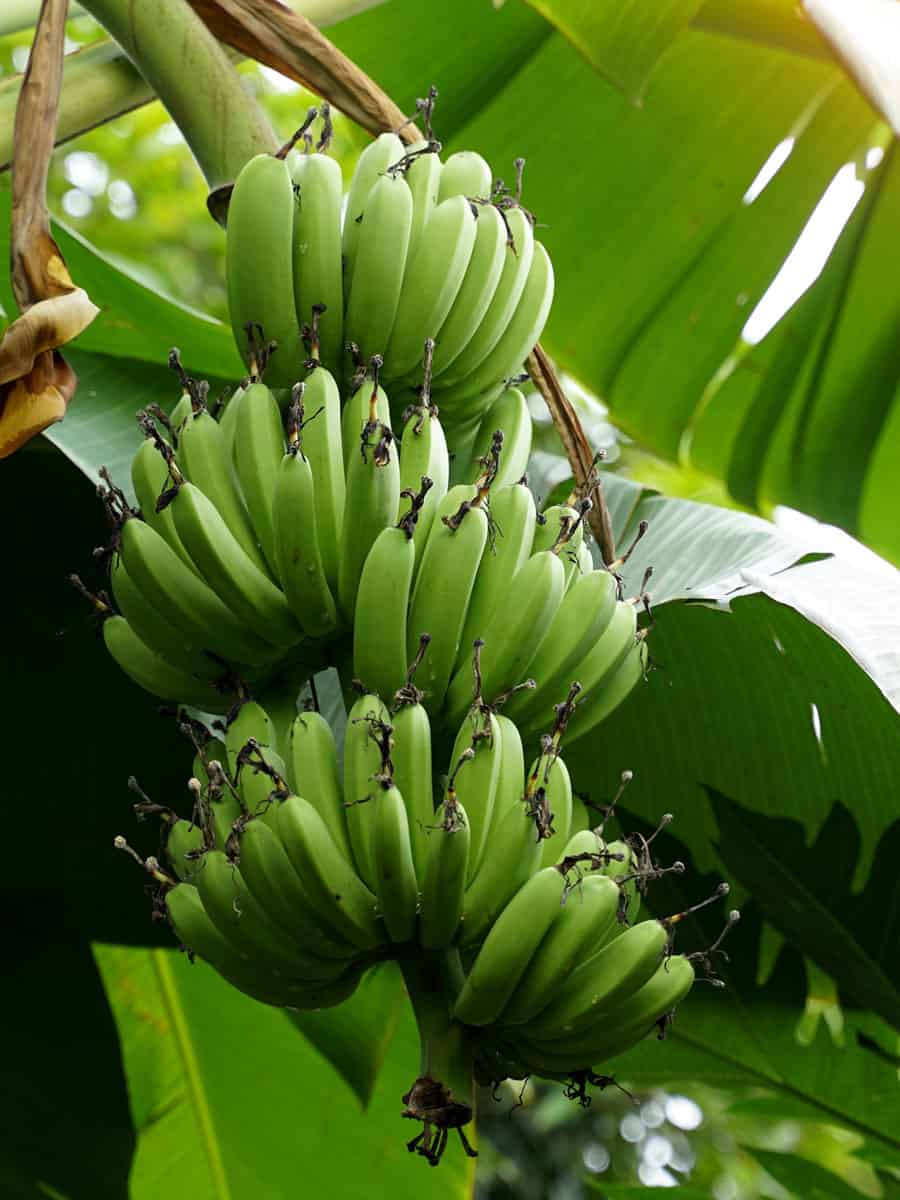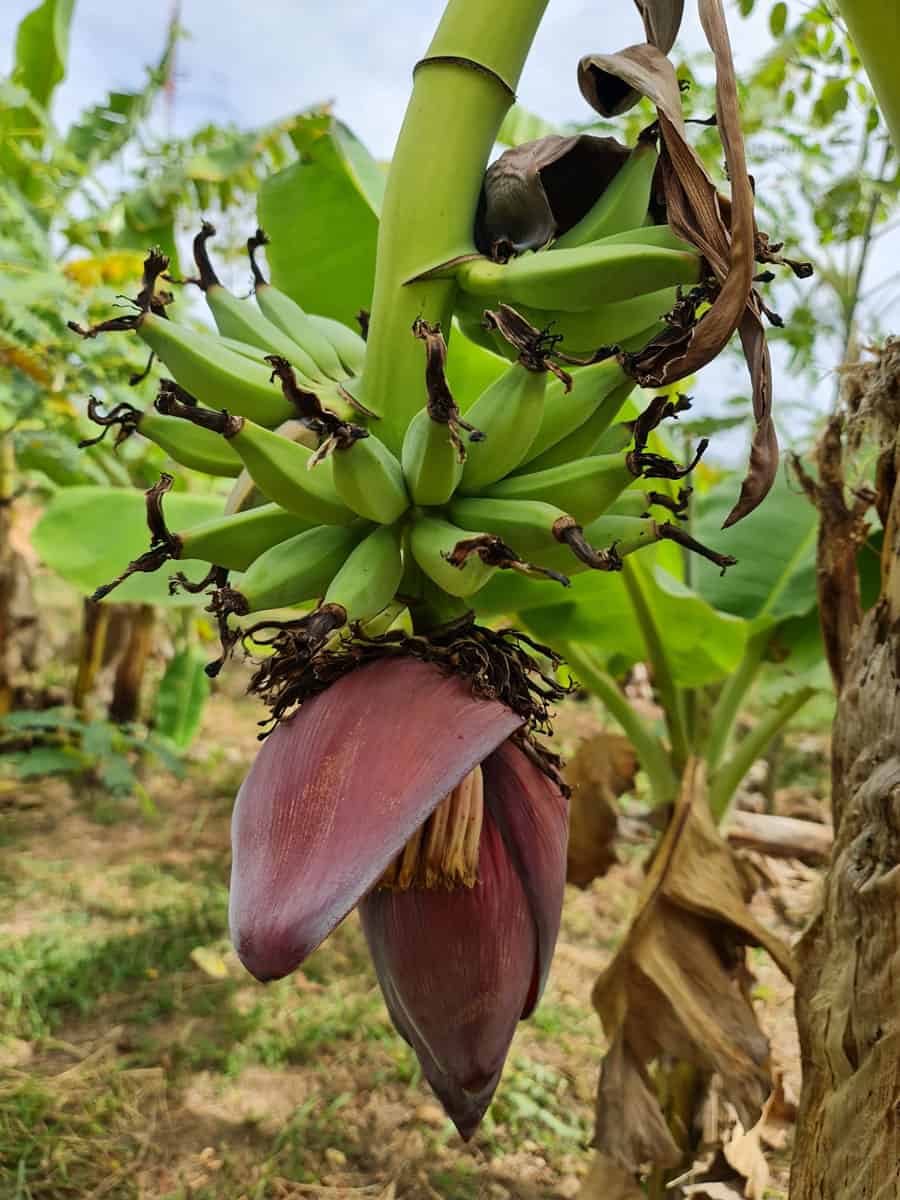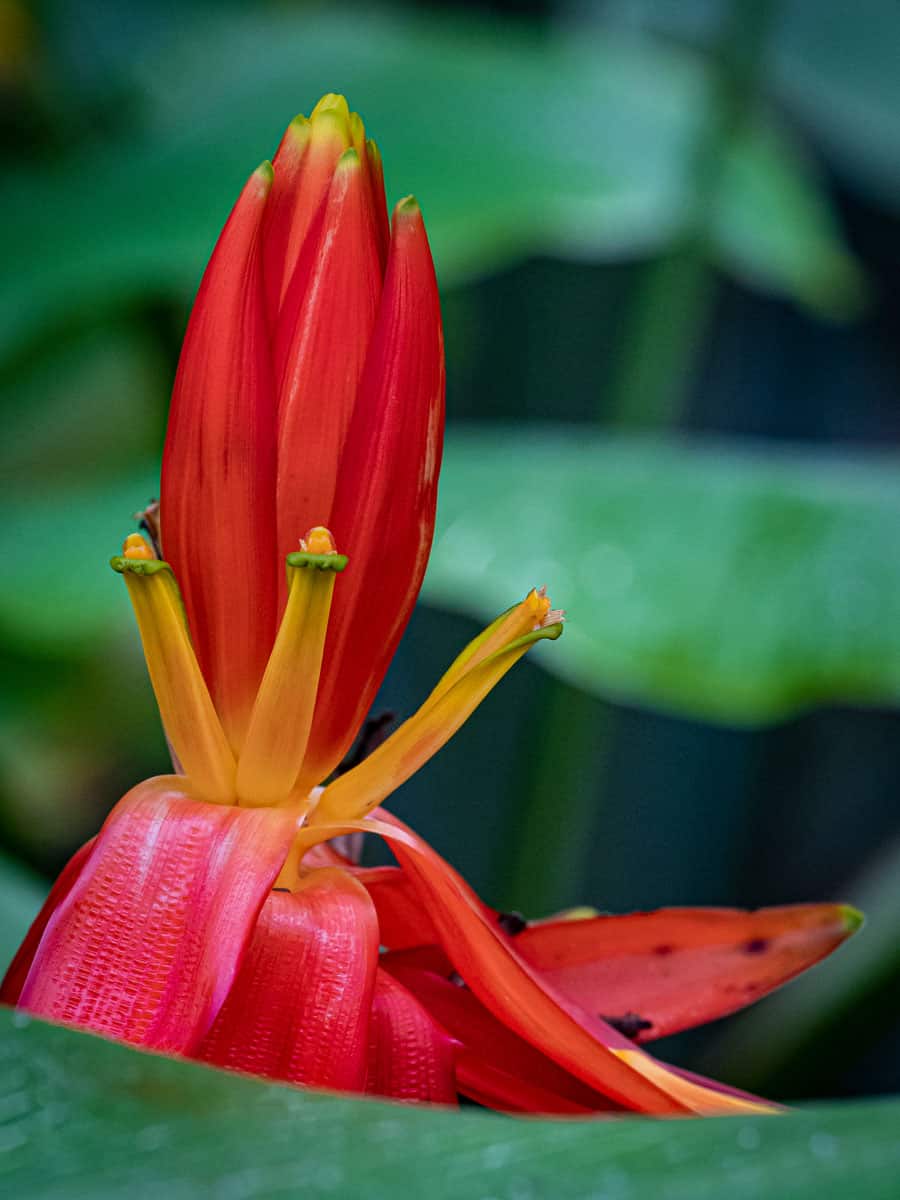What is a banana? As it turns out, there are more options available to you than just the yellow bananas you can find at the grocery store. If you're interested in growing unusual plants in your front lawn, or if you want to slash your grocery bill, you've got plenty of banana species from which to choose.

Types of Banana Plants
There are more types of bananas than you can imagine available for you to grow. Take a gander through some of your options and see may suit your home garden or orchard best.
1. Plantain

At first glance, plantains (Musa paradiciaca) look like your standard bananas. However, they have a significantly higher starch content than regular bananas and are considered vegetables instead of fruits. That said, you can readily use them in desserts, so long as you cook them before eating them. There's no harm in eating an uncooked plantain, but many cultures prefer them glazed or warmed.
If you're growing plantains at home, make sure that you plant your plantain trees in well-draining soil. Plantains thrive when exposed to partial sun for at least eight hours, but you'll need to ensure that their roots don't rot.
Click here to find plantains on Amazon.
2. Hardy Banana

Hardy bananas (Musa basjoo) are also known as Japanese fiber bananas and are some of the easiest bananas to grow around the world. These bananas can not only survive temperature springs and summers, but they'll continue to grow even after they've been exposed to below zero temperatures.
Hardy bananas don't need much babying to grow. Give them plenty of sunlight and an appropriate amount of mulch, and you'll be able to enjoy these bananas for years to come.
3. Blue Java Banana

Blue java bananas don't taste like coffee. Instead, most people love blue java bananas because they taste like ice cream! The banana's vanilla flavor and creamy fruit, combined with its strange blue peel, make it an extravagant treat for even the pickiest of palates.
Unlike many bananas, the blue java banana is relatively hardy. You'll be able to grow these bananas in colder regions without worrying about losing your crop. That said, these banana plants prefer well-draining soil, and you should try to plant them in partial sunlight to see the most significant growth.
4. Cavendish Banana

The banana that many have come to know and love as a "regular" banana is, in fact, a Cavendish banana (Musa Cavendish). These bananas are primarily found in Central America, but they've become a staple crop all around the world.
You can grow Cavendish bananas through a multitude of means. Dwarf Cavendish plants, for example, can produce up to ninety bananas on each frond. If you want to invest in a larger banana tree, you'll need to take pruning and root care into account. Cavendish plants of all sizes prefer full sunlight and humid environments.
5. Musa Acuminata

Musa acuminata bananas are another of the hardier banana plants that you can grow around your home. These bananas will thrive in smaller containers, full sun, and relative heat. Even so, you'll want to take care and ensure that these bananas' soil stays moist - they take in a lot of water and will need attention at least twice a week.
On average, musa acuminata banana plants can grow between twelve and twenty feet. If you need to transplant them, you'll need to fertilizer your beds appropriately, but the plants should continue to thrive.
Click here to find this banana plant at your local nursery.
6. Musa Balbisiana

Musa balbisiana bananas are a hybrid banana that grows in the wild. These bananas can withstand significant amount of stress courtesy of their unique genetic makeup. Much like the more recognizable species of bananas, these bananas prefer warmer, humid weather and full sunlight..
7. Musa Velutina

Musa velutina bananas are some of the loveliest banana plants you can grow in your yard. These plants typically don't grow over eight feet tall and sprout beautiful, pink flowers before producing their bananas. The bananas themselves are also pink and have a velvet-like skin. Unfortunately, though, these bananas aren't easy to eat - they're filled with seeds and won't make a pleasant meal.
If you want to enjoy musa velutina bananas for their appearance, make sure that you water and foster your plant until it's developed a sturdy root system. These banana plants prefer full fun but can grow successfully in winter-hardy zones.
Click here to find this banana plant at your local nursery.
8. Red Banana

Looking for a banana that's even sweeter than a Cavendish banana? Red bananas are softer than these well-known bananas and have a higher sugar content. As their name suggests, red bananas have a red to purple skin, and they can taste like raspberries to the uninitiated.
Your red banana plant will thrive in full sun, so long as it's planted in well-draining soil.
9. Musa Ornata

If you don't want a traditional banana plant in your front yard, why not invest in a musa ornata? This banana plant is more of a hedge. Given the proper care, these plants can grow up to nine feet tall and seven feet wide. These plants bloom seasonally and boast showy flowers as well as edible bananas.
Musa ornata banana plants are hardier than some of their more tropical cousins. You'll want to keep the ground around your plant moist but well-draining. If you live in a colder area, you'll want to bring your plant indoors during the winter months. When your plant reaches its fullest width and height, you can instead cover it with a garden-appropriate tarp to protect it from the worst of the cold.
10. Musa Sapientum

Musa sapientum bananas have some significant cross-over with Musa paradisiaca bananas, as many in the agriculture business refer to these bananas as the same plant. The name "musa sapientum" identifies these bananas as dessert bananas. As you might expect, these bananas are especially sweet and creamy. To successfully grow musa sapientum in your yard, be sure to cultivate the seeds or sprouts in a relatively humid environment so that they can successfully take root. Once the plant's established, you'll be able to transfer it outdoors or into a larger pot, so long as you live in warmer climes.
Click here to find this banana plant on Amazon.
11. Musa Sikkimensis

Anyone nervous about growing bananas in unusual climes will likely enjoy growing a musa sikkimensis plant. More commonly known as Red Tiger bananas, these plants can thrive just about anywhere so long as they're grown in moist, well-draining soil.
On average, musa sikkimensis plants can grow between twelve and twenty feet in height. These plants grow fairly quickly and prefer more shade than light.
12. Abaca

Abaca bananas are grown and commonly sold throughout the Philippines. While they're not as common in the West as Cavendish bananas, their popularity cannot be denied. Not only are the bananas themselves fairly popular in kitchens throughout the Philippines, Costa Rica, and Ecuador, but their fibers have been used to make rope for hundreds of years.
Abaca plants can grow to be twenty-two feet in height, but they tend to cap off at different heights depending on the climate in which they're grown. You'll be able to better control the growth of your Abaca plant by keeping yours indoors during its initial few years of growth. Afterward, you can choose to transplant a faster-growing Abaca outdoors or keep yours in a large pot.
Click here to find this banana plant through international nurseries.
13. Saba Banana

At first glance, saba bananas look more like clamshells than they do bananas. These bananas grow in the Philippines and thrive when grown in warm and humid environments. While you can eat these bananas raw, it's best to use them in cooked dishes. They do have thicker skins than most bananas, but this does not impact the taste.
Click here to see this banana on Amazon
14. Lady Finger Banana

Lady Finger bananas are more frequently known as baby bananas. These bananas are significantly smaller than the ones you typically find in your grocery store. They grow to three inches in length, at most, and are beloved for their honey-like taste.
Lady finger bananas can be found in Australia and Asia. If you're growing lady finger bananas, make sure that you water them frequently and keep them in a warm environment. Before the bananas themselves start to grow, you'll be able to enjoy the plant's bright fuchsia flowers.
Click here to see this banana on Amazon
15. Musa Hirta

Musa hirta bananas are more commonly known as Bornean Hairy Bananas, and as you might expect, they live up to that name. While not much known is about this banana, its growths begin with a bright pink flower and evolves into heavily textured, multi-headed sprouts.
Bornean Hairy Bananas are notably more juicy than starchy, making them an unusual but welcomed departure from traditional bananas. If you want to grow one of these plants in your front lawn, you'll need to do what you can to imitate Boreo's humid climate while your sprouts are first growing. These banana plants top off at eight feet in height, meaning that you'll be able to foster their growth indoors for a while before transplanting them into your yard.
Click here to find this banana plant through your local nursery.
16. Pisang Awak

You don't have to invest in an unusual banana if you want to start growing your own at home. Instead, you can always grow Pisang Awak bananas. These bananas are even more common than Cavendish bananas, and they're grown all around the world. The fruits these plants produce are a little thicker than the common banana, but they're easy to eat.
As suggested, Pisang Awak bananas are hardy and can grow in most environments. If you live in colder climes, however, make sure that you surround the base of your eventual banana tree with mulch come winter to preserve its overall health.
Click here to find this banana plant on Amazon.
17. Scarlet Banana

Scarlet bananas are, as their name suggests, scarlet. While there are a few red bananas in circulation, these are known for their darker color and relatively controlled growth. Unlike many banana plants, these hedge-like growths tend to stop growing once they hit three feet in height. However, they can grow up to five feet in width. Despite their smaller stature, these banana plants will still produce edible fruit.
Scarlet banana plants are hardy and won't easily contract diseases. If you want to add one to your yard, you'll want to propagate your seeds indoors and keep your sprouts inside until they've grown to at least two inches in height.
Click here to find this banana plant through your local nursery.
18. Goldfinger Banana

Goldfinger bananas are genetically modified bananas that were originally created by scientific teams based in Honduras. These bananas are significantly more pest-resistant than other types of bananas because they were designed to be.
Goldfinger bananas are functionally similar to Cavendish bananas. They require the same amount of sun and water to grow successfully, and they can be eaten cooked or raw.
Click here to find this banana plant on Amazon.
19. Musa Troglodytarum

Musa troglodyyarum bananas are more commonly known as Fe'i bananas. These plants grow bananas that are brown and are prized for their taste. Having originated in the Pacific islands, these bananas now make up a significant portion of native diets and can be eaten both raw and cooked.
You can purchase these plants as saplings, but anticipate a bit of growth. It's best to foster these initial saplings indoors, where you can control the humidity to the banana's liking. After it's established a strong root system, you'll be able to transplant it out into your yard.
Click here to find this banana plant on Amazon.
20. Musa Nagasium
No banana plant will make quite as significant an impact on your yard as a musa nagasium. These banana plants will grow up to thirty-three feet in height and produce some of the strangest fruit that you can still call a banana. Musa nagasium plants produce clusters of purple fruits that form cylindrical points.
This banana plant makes its native home between the Himalayan mountains and Yunnan, China. That said, it tends to thrive in most warm or temperate climates. While you won't be able to eat the pseudo-stems it produces, you can still enjoy how their appearances enlivens your front lawn. Be sure to foster your plant's growth and allow its root system to form before transplanting it out into your yard. If you live in colder climes, you may want to keep this plant indoors for its first few years.
Click here to find this banana plant through rare seed inventories.
21. Musa Yunnanensis

Musa yunnanensis bananas are more commonly referred to as wild forest bananas. These bananas get their Latin name from their native orchards of Yunnan, China. While this banana is not new to the world of agriculture, it was originally identified in 2005 and since has become a better-understood addition to the Musa family.
If you're looking to grow musa yunnanensis bananas for yourself, you'll be able to enjoy a waxy, relatively tall plant along with fruits that are beloved by local wildlife. Musa yunnanensis plants can grow up to sixteen feet tall, and their fruits are a hit with many species of bats and birds. You'll want to foster this plant in a humid environment and ensure that its soil remains moist before transplanting it into your yard.
Click here to find this banana plant through your local nursery.
22. Musa Ochracea
For a bit of additional color in your yard, you may want to consider musa ochracea bananas. These bananas are traditionally found in Asia's warmer climes. They produce odd, off-red, and conical growths that add a Dr. Seuss sensibility to your front yard.
Musa ochracea bananas are a relatively new addition to the banana family, as they were first discovered in 2011. At this time, it's not clear if they're the best banana plant to keep in your front yard, but their value can't be underestimated. If you're looking to cultivate this plant, make sure to keep it in a humid area until its roots have developed. From there, you'll need to provide it with much the same care as other banana plants to see it flourish.
23. Musa Muluensis

Musa muluensis bananas are another unusual-looking banana plant that thrives on the island of Borneo. These plants can grow up to thirteen feet tall and produce finger-long, red fruit and buds.
While it's said that, like other bananas, musa muluensis may thrive if kept in a tropical nursery, few reports on cultivation exist as of yet. Think you're up for a challenge?
Click here to find this banana plant through your local nursery.
24. Musa Arunachalensis

There's not much known about musa arunachalensis bananas. These bananas were newly discovered by representatives of the University of Calicut in Kerala, and it's not entirely clear how easily they can be grown in your front yard. That said, these bananas are striking to look at, with large, red, pointed flowers growing from a single stem before the bananas themselves start to grow.
Click here to find this banana plant through international nurseries.
25. Musa Maclayi
Finally, why not consider growing Musa Maclayi bananas? These bananas aren't, admittedly, great for eating. However, their spring flowers and bright red sap make them an excellent visual addition to your yard.
Musa Maclayi bananas are native to Papua New Guinea and prefer humid weather and warmer temperatures. You'll want to make sure that you water your banana plants consistently and that they receive at least eight hours of sunlight a day.
Click here to find this banana plant through international nurseries.







Can you send me details about gal banana tree